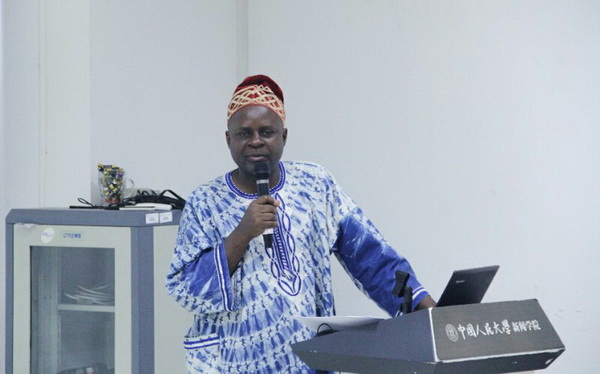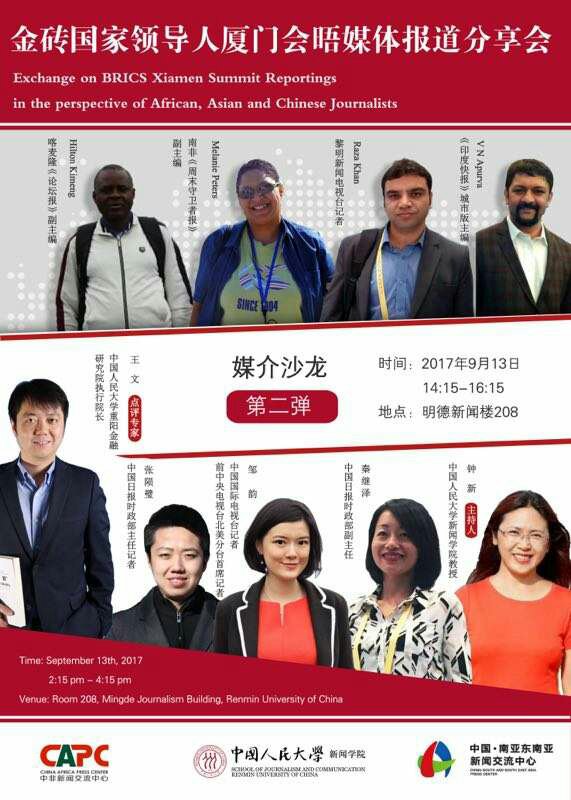


Kimeng Hilton Ndukong talked on lessons learnt from the Ninth BRICS Summit in Xiamen by journalists. Photo: CAPC
The Ninth BRICS economic bloc summit, which held in the southeastern Chinese city of Xiamen from September 3-5, 2017, is now history. History not because the experiences garnered, discussions held and decisions reached at the gathering have already been forgotten. Rather, it was an enriching experience full of discoveries and challenges – especially for journalists.
Glance at Xiamen Summit
The Xiamen summit of 10 world leaders – five from BRICS and five other guests - offered yet another opportunity for journalists to meet colleagues, make friends, share thoughts on a number of professional issues, be interviewed by other media practitioners, discover Xiamen, its cuisine, etc. Though only 10 world leaders were present in Xiamen, compared to almost 30 at the May 14-15, 2017 Belt and Road Forum on International Cooperation in Beijing, it was no less important as the summit was covered by 3,000 journalists from across the globe.
Good Media Facilities
Again, unlike last May’s Belt and Road Forum, the BRICS summit in Xiamen had better equipped Media Centre with enough desktop computers and super high-speed Internet connection. Moreover, journalists had unfettered access to the Google search engine and other New Media platforms not often permitted in China. This greatly facilitated their work.

Volunteers, including telecommunications experts, were always present to offer a helping hand when requested. There was abundant food, tea and coffee throughout the summit at the Media Centre. So, everyone ate and drank to their fill. Simultaneous translations of Chinese President Xi Jinping’s live speeches were available through headsets from journalists’ tables. The special BRICS Xiamen Summit website and the abundant printed literature provided by organizers on the economic bloc were of great help.
Media Coverage Hiccups
However, there were a number of challenges in getting information. Journalists at the media centre found it difficult to know what other leaders – be they BRICS members – said at the summit and various sideline fora. This is because their speeches were not aired on the giant projector screens in the Media Centre. The official website, to my knowledge, did not promptly publish such information. Even President Xi Jinping’s speeches often took too long to be published or released to the press.
Moreover, most of the information on the BRICS special website had to do with activities leading up to the summit in Xiamen. The statement issued by BRICS leaders at the end of the summit also took too long to be published on the official website. I do not remember if it was available online by midday of the closing day on September 5, 2017. Again, to my knowledge, the few pictures available on the website were those illustrating articles. Journalists who counted on getting many pictures of onsite summit activities were disappointed. Consequently, most of the pictures I used were taken on the giant projector screens whenever an event was aired.

Participants at the media salon on Xiamen BRICS summit at Renmin University of China, Beijing. Photo: CAPC
Personal Coverage Plan
Before leaving for Xiamen, I planned to write at least three stories, given that the event was to last three days and my paper, Cameroon Tribune, is a daily. The first story naturally had to with the opening ceremony and any important announcements made. The second article was to be on events of the second day of the summit, depending on what would be most striking. Finally, my plan was to do the third story on the content of the final communiqué or the concluding press conference.
Implementation Challenges
At the end, things worked out according to plan. I was able to get information either from live projections on the giant screen in the Media Centre, sideline press conferences, BRICS official website, and the Internet in general. This was because speeches of African and other world leaders were not aired in the Media Centre, neither was the information available on the official website.
The situation became even more frustrating when we filed our stories only to be informed late in the evening that an African leader spoke at an event during the day! Imagine your story being published back at home the following day without any mention of what the African leader said. Yet, the international media and presidential press teams of the countries concerned reported this abundantly.
Writing The Final Story
The story on the end of the summit was the most difficult to write and send. This was because we left Xiamen immediately after President Xi Jinping’s press briefing. In the mad rush, I forgot my notebook in the hall where the briefing held. We travelled that afternoon to Yinchuan in Ningxia Hui Autonomous Region after a transit flight through Xi’an in Shaanxi Province.
I had started writing the article at the venue of the presidential press briefing while waiting for the event to begin. This part of the story concerned what the African Union Chair, President Alpha Condé of Guinea and President Jacob Zuma of South Africa said on the second day of the summit. The information was only available on Guinean and South African websites.
The article was completed at night during the flight from Xiamen to Xi’an. It was while we waited at Xi’an Airport for the connecting flight to Yinchuan that I sent the article at about 10 pm. Fortunately for me, the seven-hour differential between China and my country, Cameroon, played to my advantage as the story arrived on time to be published in the following day’s issue.
Looking Into The Future
In order to offer greater visibility to BRICS in Africa, China should in future consider inviting many journalists from the continent to cover summits – no matter where they are held. BRICS is fairly young and not well known in Africa. Because most African media cannot afford to send reporters to cover BRICS summits, the need for China’s assistance becomes pressing.

Prof. Zhong Xin of the School of Journalism and Communication, Renmin University of China, Beijing, moderated discussions at the media salon. Photo: CAPC
As the 10th BRICS leaders’ summit holds in South Africa in 2018, African media coverage of the event will largely concern invited countries. Apart from us – 27 African journalists from 27 countries taking part in the 2017 China-Africa Press Centre, CAPC fellowship programme – the only other journalists from Africa who covered the Xiamen BRICS summit were those accompanying President Jacob Zuma of South Africa as member country of the economic bloc. The others came with the Egyptian and Guinea leaders who were invited to the summit.
In Conclusion
In spite of the foregoing challenges, it could safely be said again that coverage of the Ninth BRICS Summit in Xiamen was an enriching experience for many journalists. They came, saw and reported BRICS’ transition into its second “golden decade” – thereby enabling readers and audiences across the world to be kept abreast of what the economic bloc is doing and intends to do in the near future. This information will for long remain fresh in the minds who research on BRICS.
*This evaluation lecture was presented at a media salon on the Ninth BRICS Summit in Xiamen, China, at Renmin University, Beijing, on September 13, 2017. Kimeng Hilton Ndukong is Sub-Editor for World News with Cameroon Tribune bilingual daily newspaper in Cameroon. He is currently a 2017 China-Africa Press Centre, CAPC fellow.
 Fire brigade in Shanghai holds group wedding
Fire brigade in Shanghai holds group wedding Tourists enjoy ice sculptures in Datan Town, north China
Tourists enjoy ice sculptures in Datan Town, north China Sunset scenery of Dayan Pagoda in Xi'an
Sunset scenery of Dayan Pagoda in Xi'an Tourists have fun at scenic spot in Nanlong Town, NW China
Tourists have fun at scenic spot in Nanlong Town, NW China Harbin attracts tourists by making best use of ice in winter
Harbin attracts tourists by making best use of ice in winter In pics: FIS Alpine Ski Women's World Cup Slalom
In pics: FIS Alpine Ski Women's World Cup Slalom Black-necked cranes rest at reservoir in Lhunzhub County, Lhasa
Black-necked cranes rest at reservoir in Lhunzhub County, Lhasa China's FAST telescope will be available to foreign scientists in April
China's FAST telescope will be available to foreign scientists in April "She power" plays indispensable role in poverty alleviation
"She power" plays indispensable role in poverty alleviation Top 10 world news events of People's Daily in 2020
Top 10 world news events of People's Daily in 2020 Top 10 China news events of People's Daily in 2020
Top 10 China news events of People's Daily in 2020 Top 10 media buzzwords of 2020
Top 10 media buzzwords of 2020 Year-ender:10 major tourism stories of 2020
Year-ender:10 major tourism stories of 2020 No interference in Venezuelan issues
No interference in Venezuelan issues
 Biz prepares for trade spat
Biz prepares for trade spat
 Broadcasting Continent
Broadcasting Continent Australia wins Chinese CEOs as US loses
Australia wins Chinese CEOs as US loses